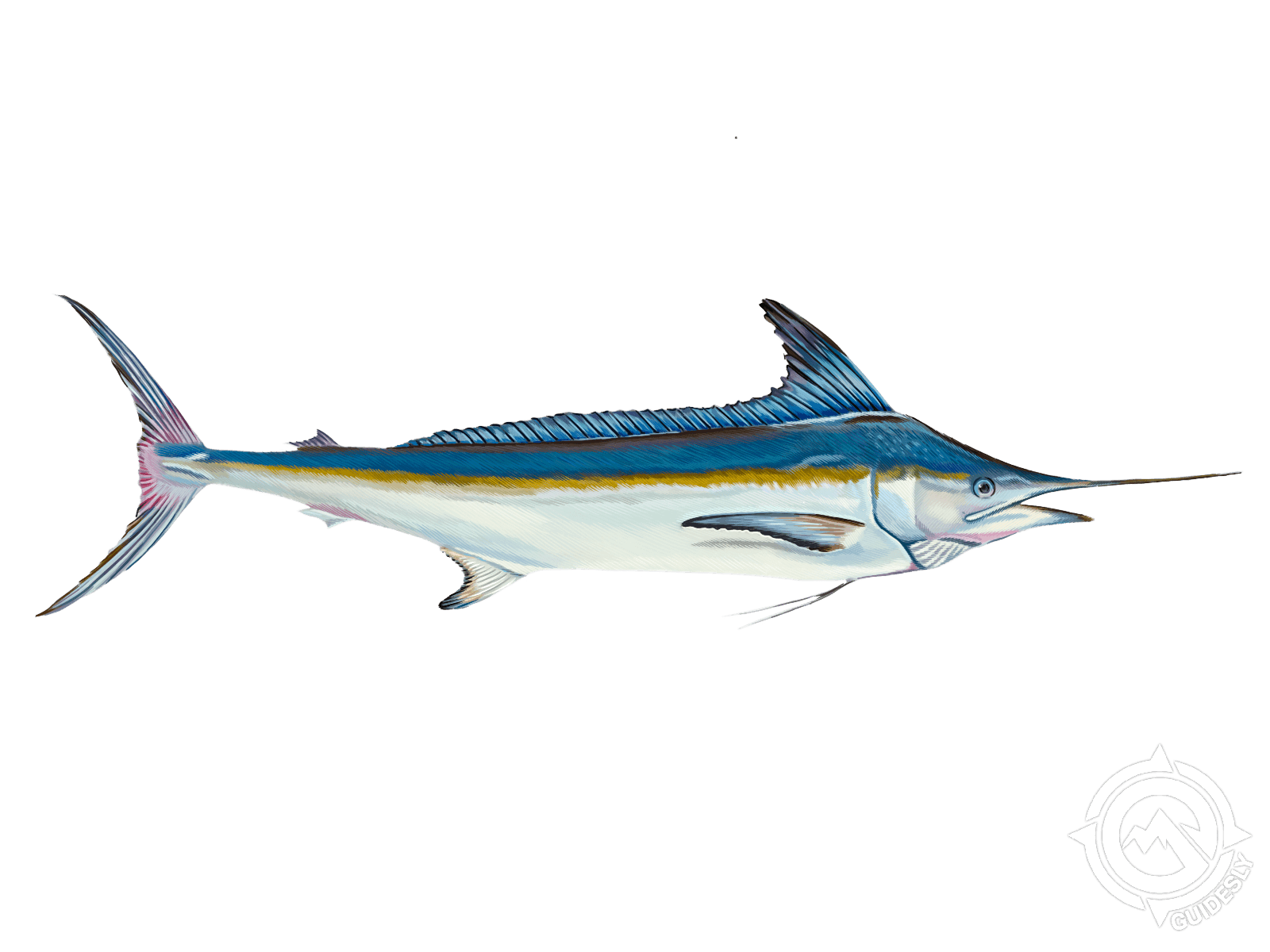White Marlin

Species Details
Kajikia Albida
Istiophoridae
Perciformes
Offshore
45 - 65 lbs.
50" - 118"
White Marlin (Kajikia Albida) Fish Description
The White Marlin is a billfish that is commonly mistaken for a Roundscale Spearfish. Visually, they both look similar. Both the White Marlin and Roundscale Spearfish have a dark blue dorsal side. They both have dirty white underbellies. Even their fins may look the same if not given a closer look. However, one way to tell is if you take a look closely, fins of the Roundscale Spearfish are more truncated than that of a White Marlin. A good number of Roundscale Spearfish appear as if their dorsal fins had been cut by a hatchet. Whereas, the White Marlin’s fins are not that badly truncated. Another thing to note is if it has spots. A White Marlin has spots on its dorsal fin whereas the Roundscale Spearfish has none.
Next, the scales. Though this takes a really close look. The Roundscale Spearfish (obviously) gets its name from its rounded scales whereas the White Marlin has rigid scales.
Finally, check their anal vent. The anal vent should be near the anal fin. If the anal vent is beyond 6 inches, that’s not a White Marlin. That’s a Roundscale Spearfish. For White Marlins, the average distance between its anal vent and the anal fin is around 2 inches.
White Marlin Diet and Size
White Marlin are considered the top of the food chain most likely because of their speed and their bill. With their bill, they can impale any of their prey with little difficulty. Along with their slender body, they have little friction to contend with which makes them a terrifying thing to be chased after.
White Marlin often chase after a school of Flying Fish and small tuna. They also like chasing Mahi-Mahi, also known as the Dolphin Fish or the Dorado. White Marlin also has a preference for squid.
Their hunting style is via diving. You’ll notice in movies and media that they’re known for jumping out of the water. That’s usually a sign that they’re hunting. Once the White Marlin leaps up, it dives down and uses the pressure and force gained from that diving to pierce through their prey.
White Marlin, as an apex predator, can grow up to 9.2 feet and weigh at around 82 kg (180 lbs).
Interesting Facts about the White Marlin
- White Marlins apparently don’t have a swim bladder.
- White Marlin has some bubble-shaped chambers that serve as its swim bladder.
- White Marlins are one of the few that use other apex predators.
- A predator’s behavior oftentimes doesn’t involve a mutual agreement or a truce. However, the White Marlin can work together with other apex predators to make the most out of their hunt.
- White Marlin can selectively warm their eyes.
- Their ability to warm their eyes comes from their attempt to hunt for fish at a deeper depth.
- Female White Marlins are bigger than male White Marlins.
- White Marlins don’t have gill rakers.
- They use their small teeth to grind their prey.
- A White Marlin’s breathing mechanic works similarly to a sports car.
- In order to get optimum performance, White Marlins have to constantly move to breathe. Same with sports cars that have to constantly have to move otherwise, they’ll blow their engine.
- White Marlin are known to make trans-Atlantic journeys.
- They do this to keep on breathing.
- Originally, the White Marlin and Roundscale Spearfish were tagged as one and the same species.
- However, a DNA test was performed which eventually separated the two.
- This led to a new categorization of the White Marlin as part of the Kajikia genus.
White Marlin – Fishing Techniques: How to Fish for a White Marlin
Fishing for White Marlin is like bumping heads with a fellow hunter. They will know you’re hunting and they know how to put up a fight. On appearance, you’re probably going to look like you’re cruising in the middle of nowhere and reflecting on the meaning of life. But actually, that’s the game: it’s being able to anticipate the strike of the White Marlin. It is called an apex predator for a reason.
Still, it’s still a fish so there’s some limit on its intelligence. One technique is via trolling with dead bait. Meaning, you have to make your dead bait look like it’s alive. First thing’s first: set up your bait. Some anglers prefer using a Ballyhoo. They normally attach it to a circle hook. However, some others would prefer using a small swivel with Monel Wire set-up. By tying the bait and a 1/4-to-5/8-ounce egg to the swivel, it’ll allow the bait to swim around as if to seduce the White Marlin.
Unlike other fish, you don’t look at the bait. You have to watch more the area within the vicinity of the bait. Either behind or at least nearby it. White Marlin are like thieves; they can strike and zoom away before you know it. Once they strike, it’s not good to reel it right away. Let it drag the bait (but don’t lose your rod!). The next is more instinctive, once you’re sure it’s eating the bait – reel it in. It’s a heavy fish so prepare for a big fight. It’s good also to have some assist with the leadering (or wiring) to make sure the fish stays in one place. That apex predator isn’t going to come into your boat willingly.
Don’t worry if you lose it on your first try. Tangoing with a White Marlin is a really big undertaking. So, it’s okay if you take several tries.
White Marlin Habitat and Distribution
White Marlin aren’t known to stick in one area due to their need to keep moving in order to breathe. The best way to find them is through the temperature of the water. They prefer deep open parts of the ocean in tropical or temperate climates.
However, they are known to roam near underwater canyons, pinnacles, and shoals.







